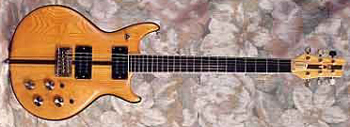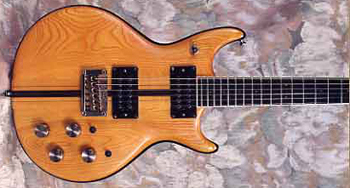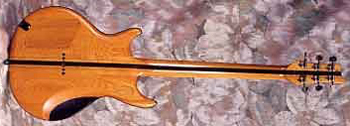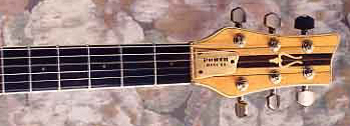Back in the 1970s there was a lawyer in Madison, Wisconsin, where I was living at the time, who ran for District Attorney on the slogan “Only obey good laws.” They call it “Mad-town,” after all! (He didn’t win, despite my vote, alas.) One of my favorite “good laws” I always follow is the law of unintended consequences. In many ways, the spectacular Japanese-made 1982 Daion Savage Power Mark XX shown here was the offspring of something intended to end, or at least seriously damage, Japanese guitar-making itself… In other words, this guitar shouldn’t exist.

1982 Daion Savage Power Mark XX Electric Guitar
The event in question was the practice of copying American guitar designs by Japanese manufacturers. The Japanese hit on the copy strategy pretty early on. The American guitar industry was pretty robust when the guitar boom hit in the early 1960s. But it couldn’t meet the total demand of maturing Baby Boomers and the gap was filled by European guitar makers such as EKO and Framus. By 1966 or ’67 the Japanese had begun to copy European guitars that were popular in the US market, most notably the EKO violin guitar (itself just one of many Euro takes on the Gibson EB-0 bass).

1982 Daion Savage Power Mark XX Electric Guitar
The turning point, in a delicious irony, was precipitated by Gibson. Gibson had dominated the high end of electric solidbody guitars with its ‘50s Les Paul models. Glued-in necks on a mahogany body with a carved maple top. Yum, yum! But Gibson got bored with the design in 1961 and changed the Les Paul over to what would become the SG. Contract problems with Les ended the model name soon thereafter. The SG did ok, but not as well as the Les Paul. The times had something to do with it. Gibson made nice with Les and reintroduced the Gibson Les Paul in 1968. The version it chose to resuscitate was the black-finished Les Paul Custom.
What follows is somewhat apocryphal. Meaning there’s no incontrovertible proof. Shiro Arai, the man behind Aria guitars, was at the 1968 NAMM show where the reissue LP Custom was featured. He took one look at it. Hmm. It’s a copy of the old Les Paul. Copy!!!

1982 Daion Savage Power Mark XX Electric Guitar
The first Japanese “copies” of the Les Paul Black Beauty appeared the following year—bolt-on necks and not precise by any means. But it didn’t take long for the notion to blossom. By 1974 at least the Japanese were building copy guitars that were nearly as good as the originals. Certainly as good looking, and a heckuva lot cheaper. Gibson was—understandably—not happy.
In the summer of 1977 Norlin, Gibson’s parent company, sued Elger Guitars, the American arm of Hoshino, owner of the Ibanez brand name, in Philadelphia Federal Court. The charge was trademark infringement, based on the copying of Gibson’s headstock design. The plan was to seriously damage the Japanese makers. You know, sweep into the Summer NAMM show and scoop up the entire Ibanez display. Take that! Of course, here’s where the unintended consequences come in.

1982 Daion Savage Power Mark XX Electric Guitar
First of all, Gibson hadn’t noticed that Ibanez had already changed its headstocks. In an amusing twist, they actually looked more like Guild heads grafted on Gibson guitars! No confiscations. Furthermore, Elger reached an out-of-court settlement agreeing not to copy Gibson headstocks. More importantly, the lawsuit gave Hoshino a kick in the pants toward coming up with new designs that American guitarists wanted anyway. The copy era had run its course. Americans wanted natural-finished guitars made out of exotic woods. The result was Ibanez Musicians, Aria Pro II Rev Sounds, and various very cool Westones. Not to mention Travis Beans and Kramers.
Which brings us back to this guitar, which appeared right in the middle of that natural craze. Daion was a brand that debuted in 1978, part of a collaboration between MusiConics International, Inc. (MCI) of Waco, Texas, best known as the makers of the legendary Guitorgan, and the luthier Hirotsuga Teradaira, a maker who specialized in cedar-topped guitars outfitted with brass nuts and saddles for increased sustain. The most famous product of this liaison was the asymmetrical acoustic-electric Daion Headhunter.
Daion introduced its first solidbody electrics—the Power series—in 1981 or thereabouts. There were two basses (Power Mark X-B, Mark X-B2) and either two or four guitars (Power Mark X, Mark XX, Mark XXV, Mark XXX). The Mark XX shown here (#820397) was the top of the line. This is just spectacular. First of all, it’s a neck-through-body guitar, the neck core consisting of two thick strips of rosewood with a thin piece of maple in the middle sandwiched between four plies of maple, two per side, themselves separated with a thin slice of rosewood. The wings of the body are another sandwich, this time two pieces of nicely figured ash on either side of another layer of rosewood. The beauty of the sandwich notion is that when you carve out a contour, like on the back of the beauty, you reveal the gorgeous rosewood. It would be unthinkable in these days of dwindling rainforest to use this much rosewood on a solidbody! Another law I always obey is when an electric guitar is made out of a good chuck of rosewood: buy it!
Of course there’s also the de-rigueur brass fittings and a pair of coil taps on the ballsy humbuckers. Did I mention the original green alligator hardshell case? This is sweet.
Daion actually produced several other models, including the cool Savage line, but the Power Marks are superfine examples of Japanese lathery flexing its considerable muscles following Gibson’s ill-timed attempt to put the kibosh on Japanese guitar making. They never could have imagined that their efforts to end copying would be so successful yet lead to guitars like this Daion Power Mark XX. Good name. Good law.

I just read your article while waiting for my flight and I’m impressed with your content. You have several bold and original ideas that I can relate to and respect.
They need to fix the Coin hack then it would be awsome
do these guitars have switches for in phase & out of phase?
Have an identical Daion to the one in the photographs. I bought it in early 2000’s second hand here in South Africa. Paid the equivalent of US$ 300 for it + original hard case. A work of art which is an absolute pleasure to work with. Wonderful all-rounder, I play play blues/rock/country/jazz and other and it fits them all. I wouldn’t trade it for a Gibson or a Strat!!!! So happy to find someone else who likes and enjoys these guitars as much as I do.
I nearly scored one of these beauties several years ago on EvilBay, got sniped at the last second…..I have never seen another one for sale, unfortunately….sure would like to get my paws on one………….
I believe the Power series to originate after 1976 with the knobs being made of rosewood being the earliest. The switches are for single coil or humbucker. I have one and used to belong to a Daion guitar forum. Mine is rosewood, maple, and what looks to be mahogany. It is an incredible guitar. I have an Electra copy of a LesPaul that someone put old humbucking PUs in and it is sweet too; but worth little as a collector item.
I have the sameone as in the picture with hard case hex keys mint condition never gigged perfect every time I try to get it valued they come back with the most £150 can anyone value it for me
Cheers
John I would be interested in your Mark XX, my email is zack at kerrvillelandscaping dot com…
Thanks for writing this. I have a Mark XX and have been trying for years to get more information on the history of the guitar. My serial number starts with 80. Does that mean it was made in 1980? My brother bought it new and I purchased it from him many years ago. It is a great all-around player, great feel, great tone. Thanks for writing this article.
So when is eastwood gonna do a tribute model to these???????
great article thanks for the info , I just picked one of these up …. wow amazing guitar . goes great with its big brother the daion 80w double neck, jarrodamohau@yahoo.com.au … now wheres that headhunter
I have an old Guitar from this Label and i would like to know how much it is worth now, it has some damages on the sides but it works pretty well.
Hi you, i have a question, my brother left me his old Power Mark xx Guitar and i dont know how much it is worth, i cant find this type of Guitar online to find out and sell it for a good price. Serial Number is 801681
Here is a pic of it 🙂 thx alot
https://plus.google.com/u/0/114644757819557048961/posts/Zte1tR9WVUf?pid=6142140969160741202&oid=114644757819557048961
This is meant for Brian McClatchie. I saw your post from 2012 so I don’t know if you would even see this but I own an identical Power Mark xx-B as seen in these pictures. its an 1981 issue with the original case. its in excellent shape, only flaw is its missing one of the original knobs. other than that its in like new condition. The guy I bought it from got it as payment for some other stuff back in the 90’s. stuck it in his closet and forgot about it until recently. He then sold it to me. I would not let it go for less than $1000.00 as I love the way this plays and Ido play bass. I prefer fretless and that is the only reason I would sell this gem. Let me know…
Jag har en mark 2 serie nummer 814116 i kanon skick en knopp saknas till ena tonkontrollen
I owned one back in the late 80’s. Bougt it brand new. Used Fender superbullets strings on it. The tonal quality, and range, was very good. The only problem I remember, was the “to sharp” edge on the point where the strings left the brigde. Cause of constant string breakage at this spot, I had to rub down these edges to save money….??
I bought my black solid body electric from Tippetts Music in Gulfport, MS on July 20, 1980. A birthday present to myself. I still own it and will still my passing.
Hi Michael, just came across this article while researching the PowerMark XX I just purchased. It’s not only a good resource for those of us who are interested, an enjoyable read.
My version is ’81 and it looks like it’s been sitting in a case for 37 years. The woodwork and finish is stellar.
It looks like I’m going to be deep diving into your writing. Thanks for sharing.
I own a Daion Powermark II electric guitar, which I purchased in 1982. It is the most awsome guitar I have ever played. I would never sell it.
I have a Daion Power Mark II which I purchased in 1982 at a music store in Santa Monica Ca. It is the finest guitar I have ever played. And it looks damn good. After all these years, I still play the guitar everyday.
I have on I will sell I never play it but it’s beautiful
Lafilmsound at g-mail
Made by Yamaki. Come visit us at Daions Online for more info. And by the way, Michael Wright, we are in direct contact with Hirotsugu Teradaira! Spent five days chatting with him in Copenhagen in early November, 2019. Pics of the meeting and lots of other Daion owners at the Daions Online Facebook group, too.